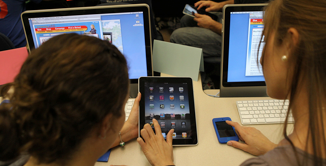
In June 2012, Apple announced it had passed 650,000 apps available in its App store, and more than 30 billion copies sold. Out of these apps, thousands are made for education and hundreds cover music content. Mobile devices are becoming ever more common and they offer brand new ways to connect students to the concepts covered in music class.
APPS
Below is a sampling of music apps currently installed on iPads and iPod Touches available from the College of Education Technology and Resource Center. Prices listed here are subject to change. To see the most up to date information, screenshots, and reviews, click on the app’s icon.
Beatwave allows students to compose music without the barrier of conventional music notation. Concepts of beat, rhythm, chords, timbre, and tempo can all be explored in an easy to use interface that students will instantly understand.
Price: FREE
GarageBand is a mobile version of the powerful recording program for Mac. It features dozens of instrument sounds that can be played by touch. It also allows students to record their own playing and combine multiple tracks to create something new.
Price: $4.99
iStroboSoft turns any iPhone, iPod Touch, or iPad into a digital tuner. The app uses the built-in microphone to display how many cents a pitch is sharp or flat. It can also be used to link music to physics concepts of sound waves and frequency.
Price: $9.99
Music Theory for Beginners introduces theory concepts in a fun game format. It covers everything from note names all the way up to aural skills and chords. Teacher Mode allows educators to unlock all levels, or require students to complete them sequentially
Price: $2.99
Subdivide Metronome is an inexpensive alternative to specialized digital metronomes. Students or teachers can create complex subdivision patterns and save them as presets to save time in future practice sessions. Also includes standard beat styles.
Price: $4.99
Symphony is a mobile music notation program. Students can explore notation through the simple touch interface and receive instant aural feedback on what they’ve created. It also is capable of importing or exporting MIDI files for use with other devices.
Price: $4.99
There are also dozens of musical instrument apps. Most are played through a touch interface, but some make use of the accelerometer in the device to provide motion control or even have players blow into the microphone to simulate wind instruments. These can be used if Orff instruments are unavailable or impractical, or simply to expose students to new sounds and build interest in music.
LEARNING TO USE THE iPAD/iPOD
DEVELOPING LESSONS
Looking for an app for a specific lesson not covered here? Searching the App Store within iTunes or on an iOS device is usually a good place to start. The music section of AppShopper also provides reviews and additional details for nearly every app.
Dr. Christopher Russell’s Technology in Music Education: How to Use iPhones, iPods, iPads, and Other Technology in Music Education is an in-depth resource for teaching ideas, choral warm-ups, recommended apps and accessories, and steps to create an iPad program in your own school.
Bowling Green State University | Bowling Green, OH 43403-0001 | Contact Us | Campus Map | Accessibility Policy

Questions, Suggestions, or Contributions? Contact Matt Rebman, rebmanm@bgsu.edu


















